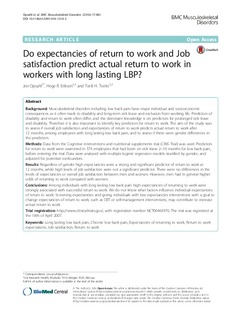| dc.contributor.author | Opsahl, Jon | |
| dc.contributor.author | Eriksen, Hege Randi | |
| dc.contributor.author | Tveito, Torill Helene | |
| dc.date.accessioned | 2018-02-01T15:09:39Z | |
| dc.date.available | 2018-02-01T15:09:39Z | |
| dc.date.issued | 2016 | |
| dc.identifier.citation | Opsahl J, Eriksen HR, Tveito TH. Do expectancies of return to work and Job satisfaction predict actual return to work in workers with long lasting LBP?. BMC Musculoskeletal Disorders. 2016;17(1):1-10 | |
| dc.identifier.issn | 1471-2474 | |
| dc.identifier.uri | http://hdl.handle.net/11250/2481918 | |
| dc.description | - | |
| dc.description.abstract | Background Musculoskeletal disorders including low back pain have major individual and socioeconomic consequences as it often leads to disability and long-term sick leave and exclusion from working life. Predictors of disability and return to work often differ, and the dominant knowledge is on predictors for prolonged sick leave and disability. Therefore it is also important to identify key predictors for return to work. The aim of the study was to assess if overall job satisfaction and expectancies of return to work predicts actual return to work after 12 months, among employees with long lasting low back pain, and to assess if there were gender differences in the predictors. Methods Data from the Cognitive interventions and nutritional supplements trial (CINS Trial) was used. Predictors for return to work were examined in 574 employees that had been on sick leave 2–10 months for low back pain, before entering the trial. Data were analysed with multiple logistic regression models stratified by gender, and adjusted for potential confounders. Results Regardless of gender high expectancies were a strong and significant predictor of return to work at 12 months, while high levels of job satisfaction were not a significant predictor. There were no differences in the levels of expectancies or overall job satisfaction between men and women. However, men had in general higher odds of returning to work compared with women. Conclusions Among individuals with long lasting low back pain high expectancies of returning to work were strongly associated with successful return to work. We do not know what factors influence individual expectancies of return to work. Screening expectancies and giving individuals with low expectancies interventions with a goal to change expectancies of return to work, such as CBT or self-management interventions, may contribute to increase actual return to work. | |
| dc.language.iso | eng | |
| dc.relation.ispartof | BMC Musculoskeletal Disorders | |
| dc.rights | Navngivelse 4.0 Internasjonal | |
| dc.rights.uri | http://creativecommons.org/licenses/by/4.0/deed.no | |
| dc.title | Do expectancies of return to work and Job satisfaction predict actual return to work in workers with long lasting LBP? | |
| dc.type | Peer reviewed | |
| dc.type | Journal article | |
| dc.date.updated | 2017-10-11T12:02:49Z | |
| dc.identifier.doi | 10.1186/s12891-016-1314-2 | |
| dc.identifier.cristin | 1435960 | |

